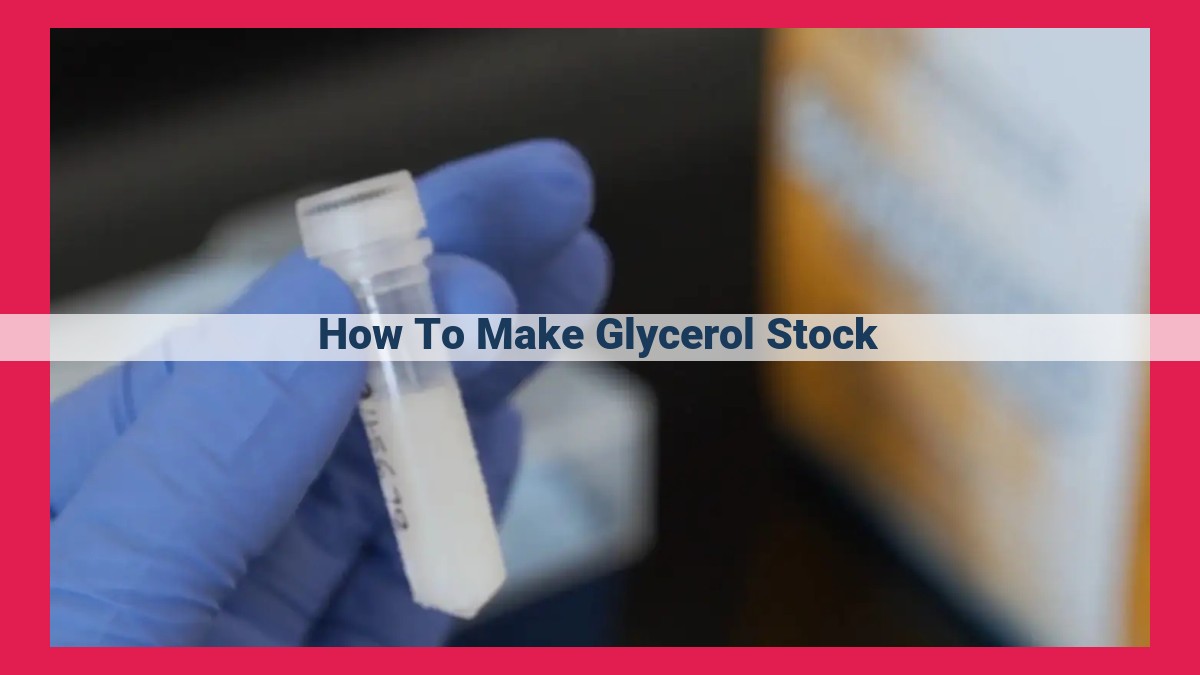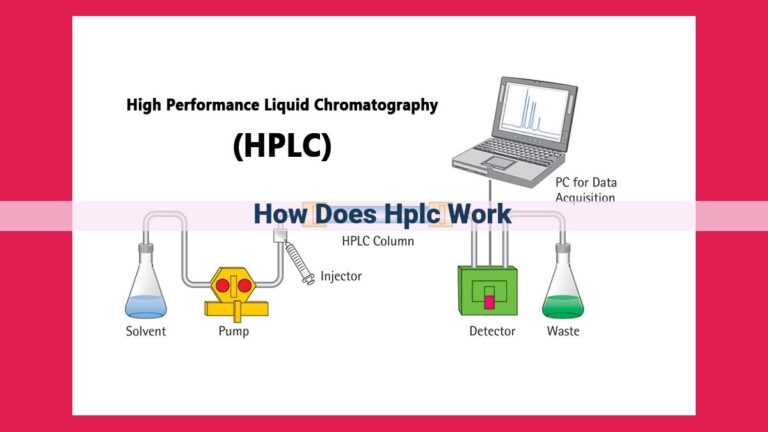Preserving Bacterial Cultures: A Comprehensive Guide To Glycerol Stock Optimization

To make glycerol stock, autoclave glycerol to sterilize it, then add it to a bacterial culture as a cryoprotectant to protect cells from freezing damage. Optimize glycerol concentration and cooling rate to minimize cell damage. Store glycerol stocks at an ideal temperature to ensure long-term preservation. Thaw stocks gradually to prevent osmotic shock and assess cell viability to ensure stock integrity. Avoid glycerol shock by using strategies like slow adaptation or gradual thawing. Store glycerol stocks in suitable freezers designed for cryopreservation.
Preserving Bacterial Cultures: A Vital Tool for Research and Industry
From unlocking the secrets of infectious diseases to developing life-saving antibiotics, bacterial cultures play a crucial role in countless scientific endeavors. Preserving these valuable resources is essential for safeguarding genetic diversity, ensuring accessibility, and advancing our understanding of microbiology. Long-term storage methods, such as glycerol stocks, enable us to maintain bacterial cultures in a state of suspended animation, preserving their viability and genetic integrity for years to come.
Creating a Glycerol Stock: A Safe Haven for Bacterial Cells
A glycerol stock is a suspension of bacterial cells in a solution containing glycerol, a sugar alcohol that acts as a cryoprotectant. By lowering the freezing point of the solution, glycerol prevents ice crystals from forming and damaging the delicate cellular structures. To ensure the sterility of the stock, the glycerol is autoclaved, a process that kills any contaminating microorganisms.
Protecting Cells from the Chilling Effects of Freezing
To further protect cells from the harsh effects of freezing, a cryoprotectant, such as glycerol, is added to the stock. Cryoprotectants help to stabilize cell membranes and reduce the formation of ice crystals. The optimal concentration of glycerol is crucial to ensure maximum protection without causing glycerol shock, a condition that can damage cells.
Controlled Cooling: A Balancing Act for Cell Survival
The cooling rate during freezing is also critical for preserving cell viability. Rapid cooling can lead to the formation of ice crystals, while slow cooling can cause damage due to the accumulation of toxic substances. Controlled cooling methods, such as using a programmable freezer, help to minimize cell damage and maximize survival rates.
Maintaining a Frozen Paradise: Ideal Storage Conditions
Once frozen, glycerol stocks are typically stored at ultra-low temperatures, such as -80°C or -196°C in a liquid nitrogen freezer. These freezing temperatures effectively halt cellular processes, preserving the viability of the bacteria. Maintaining optimal storage conditions is crucial to prevent temperature fluctuations that can compromise cell integrity.
Thawing Gently: Avoiding Osmotic Shock
When needed, glycerol stocks can be thawed to recover viable cells. However, rapid thawing can cause osmotic shock, which occurs when water rapidly enters the cells, causing them to swell and burst. Gradual thawing methods, such as placing the stock in a warm water bath, help to minimize osmotic shock and preserve cell viability.
Assessing Cell Health: Ensuring Stock Integrity
Maintaining cell viability throughout the glycerol stock preparation process is paramount. Various methods can be used to assess cell viability, including streaking the bacteria on a culture plate and observing growth. Regular monitoring of stock viability helps ensure the integrity and reliability of the culture collection.
Avoiding Glycerol Shock: A Pitfall to Watch Out For
Glycerol shock is a potential hazard that can occur during the preparation or handling of glycerol stocks. Exposure to high concentrations of glycerol or rapid changes in glycerol concentration can damage cell membranes and reduce viability. Proper techniques and careful handling can minimize the risk of glycerol shock and preserve cell integrity.
Choosing the Right Freezer: A Home for Frozen Treasures
Selecting the appropriate freezer for glycerol stock storage is essential. Freezers designed for cryopreservation offer precise temperature control, reliable performance, and safety features to ensure the long-term preservation of bacterial cultures.
Preserving bacterial cultures through glycerol stocks has revolutionized the way we store and access valuable microorganisms. By carefully controlling the preparation, storage, and retrieval processes, we can maintain the viability and genetic integrity of these cultures for decades, ensuring their continued availability for research, industry, and the advancement of scientific knowledge.
Glycerol Stock: A Guardian of Microbial Diversity
Preserving bacterial cultures is paramount for scientific research and industrial applications. Long-term storage ensures the maintenance of genetic diversity and accessibility of these invaluable resources. Among the various preservation methods, glycerol stock stands out as an effective and widely used technique.
Definition and Purpose of Glycerol Stock
A glycerol stock is a suspension of bacterial cells in a solution containing glycerol, a colorless, odorless liquid with unique properties that make it ideal for cryopreservation. Glycerol acts as a cryoprotectant, shielding cells from the damaging effects of freezing and thawing.
Properties of Glycerol for Cryopreservation
Glycerol’s high viscosity helps slow down the formation of ice crystals during freezing, reducing mechanical stress on cells. Additionally, its low freezing point (-18°C) ensures that the solution remains liquid at cryogenic temperatures, preserving cell viability. Furthermore, glycerol’s ability to penetrate cell membranes allows it to effectively dehydrate cells, reducing the risk of osmotic shock upon thawing.
Autoclaving Glycerol: Maintaining the Purity of Bacterial Stocks
In the world of scientific research, the preservation of bacterial cultures holds immense significance. These cultures serve as vital resources for studying microbial diversity, developing antibiotics, and advancing medical treatments. To ensure their long-term viability, cryopreservation techniques are employed, often utilizing glycerol as a key component.
Glycerol stocks, prepared by suspending bacterial cultures in a glycerol solution, provide a means to preserve genetic diversity and maintain the accessibility of these valuable microorganisms. Glycerol, a naturally occurring alcohol, possesses unique properties that make it an ideal cryoprotectant, safeguarding cells from the damaging effects of freezing.
However, to ensure the integrity of the preserved cultures, sterilization of the glycerol is crucial. Autoclaving, a process of high-temperature, high-pressure steam sterilization, is commonly used to eliminate contaminants and prevent the introduction of foreign organisms into the glycerol stock.
Autoclaving involves heating the glycerol to a specific temperature (typically 121°C) for a predetermined time (usually 15-20 minutes). This intense heat effectively kills any microorganisms present, including bacteria, viruses, and fungi. The pressurized environment also ensures that the steam can penetrate all parts of the glycerol solution, minimizing the risk of contamination.
Sterilization is essential for preserving the integrity of the glycerol stock. Contaminants can compete with the preserved bacteria for nutrients, alter their growth characteristics, or even destroy them. By eliminating these potential threats, autoclaving ensures the purity and reliability of the preserved bacterial cultures.
Thus, autoclaving glycerol is a fundamental step in preparing glycerol stocks. It ensures the sterility of the preservation medium, safeguarding the viability and genetic integrity of the stored bacterial cultures for future research and applications.
Cryoprotectants: Shielding Cells from Freezing’s Icy Grip
In the realm of preserving bacterial cultures, cryoprotectants emerge as unsung heroes, safeguarding delicate cells from the perils of freezing. These molecular guardians play a pivotal role in ensuring the long-term viability and genetic integrity of our microbial allies.
Among the many cryoprotectants, glycerol stands out as a trusted champion. Its unique properties make it an indispensable component in the art of cryopreservation, the delicate process of preserving cells at ultra-low temperatures.
How Glycerol Defends Cells
As temperatures plummet, ice crystals form, threatening to puncture and damage cellular membranes. Glycerol steps into the fray, acting as a physical barrier, preventing ice crystals from wreaking havoc. It also lowers the freezing point of the solution, giving cells more time to adjust to the frigid conditions.
Mechanism of Action
Glycerol’s protective abilities stem from its ability to dehydrate cells. By drawing water out, it reduces the amount of water available for ice crystal formation. This dehydration also helps stabilize cellular proteins and membranes, shielding them from the damaging effects of freezing.
Optimizing glycerol concentration is crucial for maximizing cryoprotection. Too little glycerol may leave cells vulnerable to freezing damage, while too much can induce glycerol shock, a phenomenon that can impair cell viability. Therefore, finding the goldilocks zone of glycerol concentration is paramount.
Glycerol Concentration: Striking the Balance for Cryoprotection
In the delicate dance of preserving bacterial cultures, glycerol plays a crucial role as a cryoprotectant, safeguarding cells against the perils of freezing. However, the concentration of glycerol is a delicate balance that can make or break the preservation process.
Finding the optimal glycerol concentration is paramount for cryoprotection. Too little glycerol leaves cells vulnerable to freezing damage, while too much can induce glycerol shock, a harmful osmotic stress.
Varying glycerol concentrations have distinct effects on cell survival. Higher concentrations provide better protection against freezing damage. However, they also increase the risk of glycerol shock, which can disrupt cell membranes and impair viability. Conversely, lower concentrations offer less protection but minimize the likelihood of shock.
The key lies in finding the sweet spot—the glycerol concentration that maximizes cryoprotection while minimizing glycerol shock. This concentration varies depending on the bacterial species and the specific freezing protocol used.
Determining the optimal concentration often involves experimentation. Researchers test different concentrations, assessing cell survival rates and glycerol shock incidence. This iterative approach helps refine the glycerol concentration to achieve the best possible preservation outcomes.
By optimizing glycerol concentration, scientists can effectively shield bacterial cultures from the harsh effects of freezing, ensuring their long-term viability and genetic integrity, ready to unveil their secrets when needed.
Cooling Rate: Minimizing Cell Damage
When freezing bacterial cultures for long-term preservation, controlling the cooling rate is crucial to minimize cell damage and ensure the viability of the microorganisms. This process, known as controlled cooling, involves gradually reducing the temperature of the bacterial suspension to prevent the formation of ice crystals within the cells.
Rapid freezing, without controlled cooling, can lead to the formation of large ice crystals that can physically rupture cell membranes and damage cellular components. This phenomenon is often referred to as freeze-thaw damage. In contrast, controlled cooling allows ice crystals to form slowly and in a manner that minimizes their damaging effects. The slow cooling rate allows water to gradually move out of the cells and into the extracellular space, reducing the risk of intracellular ice crystal formation.
The optimal cooling rate for bacterial preservation varies depending on the specific species and the composition of the cryoprotective solution, which we will discuss in a later section. However, general guidelines suggest a cooling rate of around 1°C per minute. This rate provides a balance between maximizing cell survival and preventing the formation of damaging ice crystals.
By carefully controlling the cooling rate, researchers can significantly improve the viability of bacterial cultures during long-term storage. This technique ensures that the preserved cultures retain their genetic diversity and remain available for future research and industrial applications.
Storage Temperature: Ensuring the Longevity of Glycerol Stocks
In the realm of scientific research and industrial applications, preserving bacterial cultures is of paramount importance for maintaining genetic diversity and ensuring the accessibility of priceless biological resources. Glycerol stocks, meticulously prepared with an optimal concentration of glycerol, serve as a haven for these microorganisms, safeguarding their viability for extended periods.
However, the journey of a glycerol stock doesn’t end with its creation. Proper storage conditions are crucial to ensure the long-term preservation of these valuable assets. Among these conditions, storage temperature reigns supreme as the gatekeeper of cell viability.
The Ideal Temperature Haven
The ideal storage temperature for glycerol stocks is a realm of frosty temperatures, typically within the frigid confines of -80°C. At this icy sanctuary, bacterial cells are lulled into a state of suspended animation, their metabolic processes slowed to a near-standstill. This icy embrace effectively halts cellular division, preventing any genetic alterations or loss of vitality.
The Perils of Temperature Swings
While -80°C remains the golden standard, even minor temperature fluctuations can pose a threat to the delicate balance within glycerol stocks. These thermal oscillations can trigger a cascade of events that can compromise cell integrity. For instance, if the temperature rises too high, cells may inadvertently awaken from their slumber, resuming metabolic activity and potentially introducing genetic mutations. Conversely, excessive drops in temperature can lead to the formation of ice crystals within the glycerol solution, puncturing cell membranes and irreparably damaging the precious bacterial cargo.
The Importance of Optimal Storage
Maintaining optimal storage conditions is not merely a matter of convenience; it’s a testament to the value of these bacterial cultures and the importance of preserving their genetic integrity. By adhering to the recommended storage temperatures and minimizing temperature fluctuations, researchers and scientists can ensure the reliability and longevity of their glycerol stocks. This meticulous care ensures that these biological treasures remain available for future generations, fostering scientific advancements and safeguarding the realm of microbial diversity.
Thawing Rate: Preventing Osmotic Shock
When it comes to glycerol stocks, thawing them is just as critical as freezing them. The process of thawing requires careful attention to prevent osmotic shock, which can damage or even kill bacterial cells.
Osmotic shock occurs when bacterial cells are exposed to a sudden change in their external environment, such as a rapid increase in the concentration of solutes (like glycerol) around them. This can cause water to rapidly flow out of the cells in an attempt to equalize the concentration gradient. This outflow of water can shrink the cells, damage their membranes, and lead to cell death.
To prevent osmotic shock, glycerol stocks must be thawed gradually. This allows the cells time to adapt to the changing solute concentration and to regulate their water balance. The ideal thawing rate is typically around 2-5°C per minute.
Here’s a simple step-by-step guide for thawing glycerol stocks:
- Remove the glycerol stock from the freezer and place it on ice.
- Gradually thaw the stock by holding it in your hand or placing it in a water bath.
- Once the stock is completely thawed, gently mix it to resuspend the cells.
- Immediately dilute the stock by adding it to a larger volume of growth medium.
- Incubate the diluted stock at the appropriate temperature for the bacterial strain.
By following these steps, you can help prevent osmotic shock and preserve the viability of your bacterial cultures.
Viable Cells: Ensuring Glycerol Stock Integrity
Ensuring the Viability of Glycerol Stocks
Preserving bacterial cultures in glycerol stocks is crucial for maintaining genetic diversity and accessibility for research and industry. However, the integrity of these stocks relies on the viability of the cells throughout the preparation process.
Assessing Cell Viability
Maintaining cell viability is paramount for successful glycerol stock preservation. Assessing cell viability ensures that the stored cells are alive and capable of growth when needed. Several methods are commonly used to assess cell viability:
- Dye Exclusion Methods: Using dyes such as trypan blue or propidium iodide, which selectively stain dead or non-viable cells.
- Resazurin Reduction Assay: A vital staining technique that measures metabolic activity, indicating cell viability.
- Plate Count Assay: A simple but effective method that measures the number of viable cells by plating them on agar medium.
Preventing Contamination
Contamination is a major threat to glycerol stocks, as it can compromise cell viability and integrity. Autoclaving glycerol prior to use ensures sterility. Sterilization by autoclaving eliminates harmful microorganisms, including bacteria, viruses, and fungi, which could potentially contaminate the glycerol stocks.
Preserving Genetic Diversity
Maintaining glycerol stocks at optimal temperature and storage conditions is crucial for preserving genetic diversity. Temperature fluctuations can damage cells and reduce their viability. Cool, stable temperatures, and appropriate cooling rates help minimize cell damage during freezing and thawing.
Thawing and Recovery
Thawing glycerol stocks requires careful handling to prevent osmotic shock. Gradual thawing in a water bath prevents sudden changes in osmotic pressure, which can damage cell membranes. After thawing, the cells should be immediately transferred to a suitable growth medium to promote recovery.
By following these guidelines, scientists can ensure the viability of their glycerol stocks, preserving the genetic diversity of bacterial cultures for future research and industrial applications.
Glycerol Shock: Avoiding Cell Damage in Bacterial Preservation
In the realm of bacterial preservation, glycerol stock plays a pivotal role in maintaining the genetic diversity and accessibility of bacterial cultures for research and industry. Glycerol, a simple polyol, acts as a cryoprotectant, safeguarding cells from freezing damage by reducing ice crystal formation and stabilizing cell membranes. However, improper handling of glycerol can lead to a detrimental phenomenon known as glycerol shock, which poses a significant threat to cell viability.
Defining Glycerol Shock
Glycerol shock occurs when bacteria are exposed to rapidly changing glycerol concentrations, causing an imbalance in osmotic pressure across the cell membrane. This sudden osmotic stress leads to water influx or efflux, resulting in cell swelling or shrinkage and ultimately compromising cell integrity.
Causes of Glycerol Shock
Glycerol shock can be triggered by several factors, including:
- Too rapid thawing of glycerol stocks, leading to a sudden increase in glycerol concentration outside the cells
- Inappropriate glycerol concentration in the stock, causing an imbalance upon thawing
- Incomplete removal of glycerol before bacterial cultivation, leading to exposure to high glycerol levels
Minimizing Glycerol Shock
To mitigate glycerol shock and preserve cell viability, several strategies can be employed:
- Gradual Thawing: Thaw glycerol stocks slowly and gradually over several hours to allow cells to adapt to the changing glycerol concentration.
- Serial Dilution: Dilute thawed cells in a stepwise manner to reduce the glycerol concentration gradually.
- Optimizing Glycerol Concentration: Determine the optimal glycerol concentration for the specific bacterial species and store stocks at that concentration to minimize osmotic stress.
- Acclimatization: Gradually expose cells to increasing glycerol concentrations before freezing to enhance their tolerance.
Glycerol shock can be a major obstacle in bacterial preservation, affecting cell viability and compromising the integrity of valuable cultures. By understanding the causes of glycerol shock and implementing appropriate strategies to mitigate it, researchers and industry professionals can effectively preserve bacterial cultures for long-term storage, ensuring their availability for future research and applications.
Freezers: The Guardians of Glycerol Stocks
The preservation of bacterial cultures is crucial for scientific research and industrial applications. Glycerol stocks play a pivotal role in this endeavor, allowing for the long-term storage of viable bacteria. To safeguard these invaluable stocks, proper storage conditions are paramount, and that’s where freezers come into play.
Selecting the Right Freezer
Not all freezers are created equal. When choosing a freezer for glycerol stock storage, it’s essential to consider factors such as temperature stability, uniformity, and reliability.
- Temperature stability refers to the freezer’s ability to maintain a consistent temperature within a narrow range over time. Fluctuations in temperature can adversely affect the viability of bacterial cells.
- Uniformity ensures that the temperature is evenly distributed throughout the freezer chamber. This is important to prevent temperature gradients that could lead to uneven cooling and cell damage.
- Reliability is crucial, as a freezer failure could compromise the integrity of the stored glycerol stocks. Look for freezers with proven track records and built-in safeguards to minimize the risk of equipment malfunction.
Features and Capabilities
Freezers designed specifically for cryopreservation offer additional features and capabilities that enhance the preservation of glycerol stocks:
- Ultra-low temperatures: These freezers can reach temperatures as low as -80°C or even -196°C (liquid nitrogen), creating an environment where bacterial metabolism is significantly slowed or halted, promoting long-term viability.
- Controlled cooling: Advanced freezers allow for controlled cooling rates, mimicking the natural freezing process to minimize cell damage. Rapid freezing can cause ice晶体 to form inside the cells, leading to cell rupture and reduced viability.
- Alarm systems: Freezers equipped with alarm systems provide peace of mind by alerting you to temperature fluctuations, power outages, or other potential problems that could jeopardize the integrity of your glycerol stocks.
- Data logging: Some freezers have built-in data loggers that track temperature over time, allowing you to monitor and document the storage conditions of your samples. This data can be invaluable for quality control and compliance purposes.
By carefully selecting a freezer that meets the specific requirements for glycerol stock storage, you can ensure the preservation of your valuable bacterial cultures, paving the way for future research and applications.





